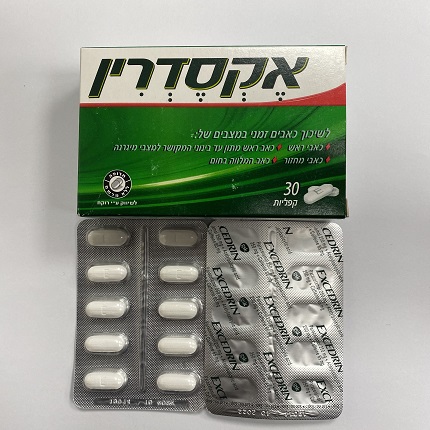Quest for the right Drug

אקסדרין EXCEDRIN (ACETYLSALICYLIC ACID, CAFFEINE, PARACETAMOL)
תרופה במרשם
תרופה בסל
נרקוטיקה
ציטוטוקסיקה
צורת מתן:
פומי : PER OS
צורת מינון:
קפליות : CAPLETS
עלון לרופא
מינוניםPosology התוויות
Indications תופעות לוואי
Adverse reactions התוויות נגד
Contraindications אינטראקציות
Interactions מינון יתר
Overdose הריון/הנקה
Pregnancy & Lactation אוכלוסיות מיוחדות
Special populations תכונות פרמקולוגיות
Pharmacological properties מידע רוקחי
Pharmaceutical particulars אזהרת שימוש
Special Warning עלון לרופא
Physicians Leaflet
Pharmacological properties : תכונות פרמקולוגיות
Pharmacodynamic Properties
5.1 Pharmacodynamic properties Pharmacotherapeutic group: Other analgesics and antipyretics; Salicylic acid and derivatives ATC code: N02B A51. Acetylsalicylic acid has analgesic, antipyretic and anti-inflammatory properties, primarily due to the inhibition of the biosynthesis of prostaglandins and thromboxanes from arachidonic acid by irreversible acetylation of cyclooxygenase (COX) enzymes. Paracetamol has analgesic and antipyretic properties, but unlike acetylsalicylic acid does not inhibit platelet aggregation. The addition of caffeine augments the antinociceptive effects of acetylsalicylic acid and paracetamol. Migraine studies The efficacy of Excedrin caplets in the treatment of acute migraine attacks was confirmed in 3 single-dose, double-blind, placebo-controlled studies and in 2 single-dose, double-blind, placebo and active controlled studies, one versus ibuprofen 400 mg and the other one versus sumatriptan 50 mg. In these studies, single-dose of Excedrin consisted of 2 tablets (500 mg acetylsalicylic acid, 500 mg paracetamol, 130 mg caffeine). In the three placebo-controlled studies, Excedrin APC was superior to placebo in reducing migraine pain intensity to mild or none 2 hours after dose in the drug–treated patients. It started relieving migraine symptoms, such as migraine pain, within 30 minutes. In a placebo and active controlled study, Excedrin APC and ibuprofen (2 tablets of ibuprofen 200 mg) were compared in the treatment of migraine. Excedrin APC was shown to deliver significantly greater pain relief than ibuprofen starting at 2 hours post dose and to deliver clinically meaningful pain relief 20 minutes faster. In another placebo and active controlled pilot study, Excedrin APC was compared with sumatriptan 50 mg and placebo for the early treatment of migraine. In this study Excedrin APC was shown to be significantly more effective than sumatriptan 50 mg at reducing migraine pain intensity throughout the 4-hour treatment period. Sumatriptan 50 mg was shown to be superior to placebo with respect to this variable, but not to a statistically significant degree. In a separate placebo and active controlled post-marketing study, Excedrin was not shown to be non-inferior to sumatriptan 100 mg. However in the acute treatment of migraine, Excedrin provided pain and symptom relief over 24 hours. Overall, the efficacy of Excedrin has been demonstrated in the relief of migraine symptoms such as headache, nausea, sensitivity to light and sound, and functional disability. Headache studies The efficacy of Excedrin tablets was studied in 4 independent, multi-center, double-blind, paracetamol 1000 mg and placebo-controlled crossover studies in the treatment of episodic tension-type headache. In all of these studies, Excedrin was shown to be consistently superior to placebo and active comparators (mono-substances) regarding all efficacy measures of pain intensity and relief throughout the observation period. Another multi-centre, double-blind, tension-type headache clinical trial compared the onset of analgesia between Excedrin, placebo and ibuprofen 400 mg. In this study, Excedrin-treated subjects reported significantly greater pain relief than placebo-treated subjects from 15 minutes through 4 hours. This finding was evident in both the Pain Relief and Responders endpoints.
Pharmacokinetic Properties
5.2 Pharmacokinetic properties Acetylsalicylic acid Absorption is generally rapid and complete following oral administration. It is largely hydrolysed to salicylate in the gastrointestinal tract, liver and blood, and is then further metabolised primarily in the liver. Paracetamol Paracetamol is readily absorbed from the gastro-intestinal tract with peak plasma concentrations occurring about 30 minutes to 2 hours after ingestion. It is metabolised in the liver and excreted in the urine mainly as the glucuronide and sulphate conjugates. Less than 5% is excreted as unchanged paracetamol. The elimination half-life varies from about 1 to 4 hours. Plasma-protein binding is negligible at usual therapeutic concentrations but increases with increasing concentrations. A minor hydroxylated metabolite which is usually produced in very small amounts by mixed- function oxidases in the liver and which is usually detoxified by conjugation with liver glutathione may accumulate following paracetamol overdose and cause liver damage. Caffeine Caffeine is completely and rapidly absorbed after oral administration with peak concentrations occurring between 5 and 90 minutes after dose in fasted subjects. There is no evidence of pre- systemic metabolism. Elimination is almost entirely by hepatic metabolism inadults. In adults, marked individual variability in the rate of elimination occurs. The mean plasma elimination half life is 4.9 hours with a range of 1.9 – 12.2 hours. Caffeine distributes into all body fluids. The mean plasma protein binding of caffeine is 35%. Caffeine is metabolised almost completely via oxidation, demethylation, and acetylation, and is excreted in the urine. The major metabolites are 1-methylxanthine, 7-methylxanthine, 1,7- dimethylxanthine (paraxanthine). Minor metabolites include 1-methyluric acid and 5- acetylamino-6 formylamino-3-methyluracil (AMFU). Combination In the combination of the three active ingredients, the quantity of each substance is low. Therefore no saturation of the elimination processes with the consequential risks of increased half-life and toxicity. Pharmacokinetic data for the fixed combination of acetylsalicylic acid, paracetamol and caffeine are in line with the pharmacokinetic profiles established either for each of the substances alone or for the combination of each analgesic with caffeine. Neither critical drug-drug interactions between acetylsalicylic acid, paracetamol and caffeine nor any increased risk of interactions with other medicinal products through their combined use are known. Findings with respect to pharmacokinetics of Excedrin were as expected, and no interactions between the 3 active substances have been observed.

שימוש לפי פנקס קופ''ח כללית 1994
לא צוין
תאריך הכללה מקורי בסל
לא צוין
הגבלות
לא צוין
מידע נוסף
